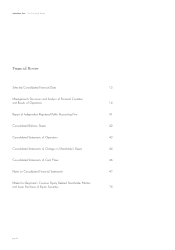Blizzard 2004 Annual Report Download - page 16
Download and view the complete annual report
Please find page 16 of the 2004 Blizzard annual report below. You can navigate through the pages in the report by either clicking on the pages listed below, or by using the keyword search tool below to find specific information within the annual report.
Significant management judgments and estimates are utilized in the assessment of when technological feasibility is
established, as well as in the ongoing assessment of the recoverability of capitalized costs. In evaluating the recover-
ability of capitalized costs, the assessment of expected product performance utilizes forecasted sales amounts and
estimates of additional development costs to be incurred. If revised forecasted or actual product sales are less than
and/or revised forecasted or actual costs are greater than the original forecasted amounts utilized in the initial recover-
ability analysis, the actual impairment charge may be larger than originally estimated in any given quarter.
Intellectual Property Licenses. Intellectual property license costs represent license fees paid to intellectual property rights
holders for use of their trademarks, copyrights, software, technology or other intellectual property or proprietary rights in
the development of our products. Depending upon the agreement with the rights holder, we may obtain the rights to
use acquired intellectual property in multiple products over multiple years, or alternatively, for a single product.
We evaluate the future recoverability of capitalized intellectual property licenses on a quarterly basis. The recoverability
of capitalized intellectual property license costs is evaluated based on the expected performance of the specific
products in which the licensed trademark or copyright is to be used. As many of our intellectual property licenses extend
for multiple products over multiple years, we also assess the recoverability of capitalized intellectual property license
costs based on certain qualitative factors such as the success of other products and/or entertainment vehicles utilizing
the intellectual property, whether there are any future planned theatrical releases or television series based on the
intellectual property and the rights holder’s continued promotion and exploitation of the intellectual property. Prior to the
related product’s release, we expense, as part of cost of sales—intellectual property licenses, capitalized intellectual
property costs when we believe such amounts are not recoverable. Capitalized intellectual property costs for those
products that are cancelled or abandoned are charged to product development expense in the period of cancellation.
Criteria used to evaluate expected product performance include: historical performance of comparable products using
comparable technology; orders for the product prior to its release; and estimated performance of a sequel product
based on the performance of the product on which the sequel is based.
Commencing upon the related product’s release, capitalized intellectual property license costs are amortized to cost of
sales—intellectual property licenses based on the ratio of current revenues for the specific product to total projected
revenues for all products in which the licensed property will be utilized. As intellectual property license contracts may
extend for multiple years, the amortization of capitalized intellectual property license costs relating to such contracts may
extend beyond one year. For intellectual property included in products that have been released, we evaluate the future
recoverability of capitalized amounts on a quarterly basis. The primary evaluation criterion is actual title performance.
Significant management judgments and estimates are utilized in the assessment of the recoverability of capitalized costs.
In evaluating the recoverability of capitalized costs, the assessment of expected product performance utilizes forecasted
sales amounts and estimates of additional development costs to be incurred. If revised forecasted or actual product
sales are less than and/or revised forecasted or actual costs are greater than the original forecasted amounts utilized in
the initial recoverability analysis, the actual impairment charge may be larger than originally estimated in any given
quarter. Additionally, as noted above, as many of our intellectual property licenses extend for multiple products over
multiple years, we also assess the recoverability of capitalized intellectual property license costs based on certain
qualitative factors such as the success of other products and/or entertainment vehicles utilizing the intellectual property,
whether there are any future planned theatrical releases or television series based on the intellectual property and the
rights holder’s continued promotion and exploitation of the intellectual property. Material differences may result in the
amount and timing of charges for any period if management makes different judgments or utilizes different estimates in
evaluating these qualitative factors.
Management’s Discussion and Analysis of Financial Condition
and Results of Operations
Activision, Inc. — 2004 Annual Report
page 18
























